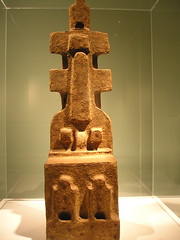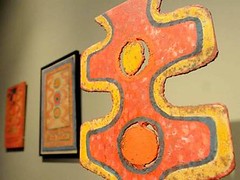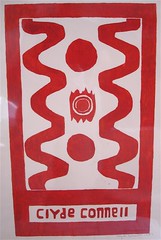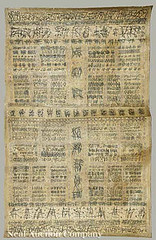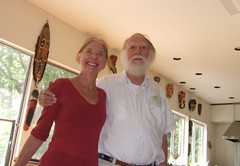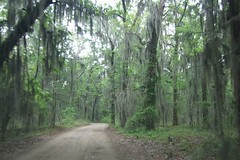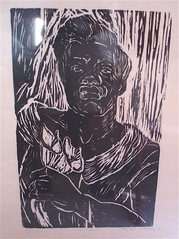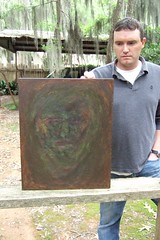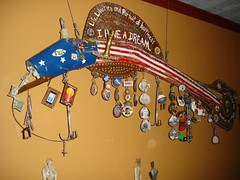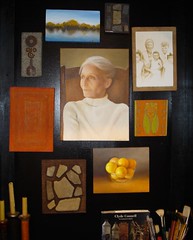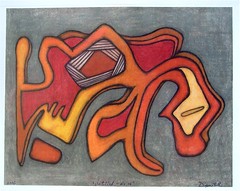Wednesday, October 23, 2019
Clyde Connell CV per Arthur Roger Gallery, New Orleans
Clyde Connell CV
Dates September 19, 1901 – May 2, 1998
EDUCATION
1925-27 George Doke Studio, Shreveport, LA
1919-20 Vanderbilt University, Nashville, TN
1918-19 Breneau College, Gainesville, GA
SELECTED AWARDS
1985 Award in the Visual Arts 5, National Endowment for the Arts and the Southeastern Center
for Contemporary Art
1984 Honor Award in the Visual Arts, National Women's Caucus for Art
1982 Gottlieb Foundation Grant, New York, NY
SELECTED SOLO EXHIBITIONS
2007 Arthur Roger Gallery, New Orleans, LA
1997 Arthur Roger Gallery, New Orleans, LA
1994 Arthur Roger Gallery, New Orleans, LA
1993 Arthur Roger Gallery, New Orleans, LA
Barry Whistler Gallery, Dallas, TX
Lone Star Visions, Art Museum of S.E.TX, Beaumont, TX
1992 Arthur Roger Gallery, New York, NY
Arthur Roger Gallery, New Orleans, LA
1990 Arthur Roger Gallery, New Orleans, LA
1989 Arnold Herstand & Co., New York, NY
1988 Arthur Roger Gallery, New Orleans, LA
Barry Whistler Gallery, Dallas, TX
1987 Songs from Lake Bistineau, Oscarsson Siegeltuch, New York, NY
1986 Arthur Roger Gallery, New Orleans, LA
Stoner Arts Center, Shreveport, LA
1985 Southeastern Center for Contemporary Art, Winston-Salem, NC
University of Southwestern Louisiana, Lafayette, LA
1985, 81 Louisiana State University, Shreveport, LA
1984 Delahunty Gallery, New York, NY
Celebration of the Arts, World's Fair, New Orleans, LA
1983 Delahunty Gallery, Dallas, TX
Firehouse Arts Center, Norman, OK
1982 Mississippi Museum of Art, Jackson, MS
432 JULIA STREET
NEW ORLEANS
LOUISIANA 70130
504.522.1999
FAX.522.6999
WWW.ARTHURROGERGALLERY.COM
Alexandria Museum of Art, Alexandria, LA
Texas Christian University, Fort Worth, TX
SELECTED GROUP EXHIBITIONS
1992 The Art of Clyde Connell, Mills College Art Gallery, Oakland, CA
1989 Different Drummers, Hirshorn Museum and Sculpture Garden, Washington, DC
1988 Just Like a Woman Greenville County Museum of Art, Greenville, NC
1986-87 Neighbors, The Museum, Lubbock, TX
1985-86 Shreveport Art, Shreveport Sesquicentennial, LA
1985 National Women's Caucus for the Arts, Los Angeles, CA
1984 Fourth Texas Sculpture Symposium, Austin TX
1983 Works by Louisiana Women, traveling exhibit, Southern Illinois University, Carbondale, IL
Collaborations, Spring Art Festival, TX
Christian University, Ft. Worth, TX
Atlantic Richfield Corporation Collection, Art Museum of South TX, Corpus Christi, TX
New Orleans Triennial, New Orleans Museum of Art, New Orleans, LA
1982 Collage and Assemblage, National Invitational, Mississippi Museum of Art, Jackson, MS
The Tampa Museum, Tampa, FL
The Alexandria Museum, Alexandria, LA
Roanoke Museum of Fine Arts, Roanoke, VA
Tucson Museum of Art, Tucson, AR
Hunter Museum of Art, Chattanooga, TN
Delahunty Gallery, New York, NY
Four Artists, Tibor de Nagy Gallery, New York, NY
1982-83 Works of Women, traveling exhibition, Gihon Foundation, Dallas, TX
1981 A Sense of Spirit, Lawndale Annex, University of Houston,
The Image of the House in Contemporary Art, University of Houston, TX
Mayor Byrne's Mile of Sculpture, Art 1982, Chicago Navy Pier, IL
First Louisiana Sculpture Biennial, Contemporary Arts Center, New Orleans, LA
Shreveport Art Guild National, Meadows Museum
Visions, Contemporary Arts Center, New Orleans, LA
1980 Sculpture 1980, Maryland Art Institute, Baltimore, MD
Louisiana Major Works, Contemporary Arts Center, New Orleans, LA
SELECTED COLLECTIONS
Alexandria Museum of Art, LA
Louisiana State University, Library Collection, Alexandria, LA
Hyatt Regency Scottsdale, Riviera Beach, FL
Commercial National Bank, Shreveport, LA
First National Bank, Shreveport, LA
Worthen Bank, Little Rock, AK
Mernel-Jacobs, Pierns & Yersh, Los Angeles, CA
Gihon-McMurray Foundation, Dallas, TX
Jay R. Broussard Memorial Gallery Collection,
Louisiana State Division of the Arts, Baton Rouge
432 JULIA STREET
NEW ORLEANS
LOUISIANA 70130
504.522.1999
FAX.522.6999
WWW.ARTHURROGERGALLERY.COM
Laguna Gloria Art Museum, Austin, TX
Metropolitan Museum of Art, New York, NY
New Orleans Museum of Art, New Orleans, LA
Prudential Insurance Company, Newark, NJ
Atlantic Richfield, Dallas, TX
SELECTED BIBLIOGRAPHY
Charlotte Moser, “Clyde Connell: 1901-1998,” Sculpture Magazine, December 1998
Roberta Smith, “Clyde Connell, 97, Sculptor Inspired by Louisiana Bayous,” The New
York Times, May 10, 1998
Holland Cotter, “Art in Review,” The New York Times, January 1992
Friday, August 2, 2013
Photographer - author Neil Johnson on the artist Clyde Connell
Essay by Neil Johnson
Who gives himself or herself a birthday gift of a visit to a friend? I did. That was the power of Clyde Connell.
Clyde was a woman of inspiration to many artists in northwest Louisiana. Named after Scotland’s River Clyde and raised on a plantation just north of Shreveport, she only left this neck of the woods to travel to New York City and other places for the Presbyterian Church and for art. She always returned to evolve her own art and eventually became a homegrown, internationally celebrated, truly original artist.
I had heard of her, but I don’t remember meeting her until I was assigned to photograph her as my first post-grad professional magazine photojournalism assignment for the newborn Louisiana Life. That 1981 assignment turned into more than a decade of 40-minute drives out to the Spanish moss-laden cypress trees on the west bank of Lake Bistineau. Having spent my high school and college summers water-skiing down its channels, I always thought of Bistineau as a place for fun escape with my ski-pals. As an adult, the lake took on new meaning as my Clyde Connell destination.
Clyde’s home-studio became, over the years, a place of inspiration for a hundred other artists, gallery curators, documentary videographers, art-lover celebrities like Lily Tomlin and even legendary photographer Mary Ellen Mark. In her later years, Clyde did not have to travel to see the world. The world traveled to see her.
Photography introduced me to Clyde and, after our friendship progressed, photography remained ever present, as it was an important avenue for her art to gain entrance to galleries and publications. Of course, I was not the only photographer who pointed a camera at her or her work, but I took it as a personal duty—and pleasure—to be regular with my medium. I don't remember ever not pulling out my camera bag while out there.
But Clyde and her work were not simply photographic subjects for me. She was about spiritual and intellectual and artistic inspiration. To be in her humble home was like meditation. Clyde, her environment, her life and her work were one. She lived her art, which was intensely about and from her immediate rural Louisiana environment combined with her worldview, which went far afield and included many social issues, especially women’s.
The best artists come about their work honestly and on their own, without people pushing them in any direction. No one but her own muse sent her down a new, quiet and interesting path, which combined a strong connection to the earth with a love for the deep mysteries of what makes us human. Her techniques and style were her own inventions. She set out to find herself and explore her world and did so intuitively and intrinsically in an creative and prolific career that began well into the second half of her long life. She lived to be 97 and did not stop making art until just before her death in 1998.
Several times, when my birthday included a chunk of unscheduled time on a weekday, I would purposely give myself the gift of driving out to Clyde’s to just sit, visit and soak in the atmosphere. These remain several of my favorite birthdays in my memory. We would sit with her in her studio and discuss current world events. On warm days with the AC window unit buzzing, she would enjoy her rocking chair, and on cold days, she would be bundled in a blanket in her easy chair. She was not an “old woman” to me. She was a woman of energy and ideas and intelligence and grace.
Many times I moved furniture out of the way in her small sitting room or dining room to transform them into studio space. I documented her sculpture and paintings for more than a decade and was honored to create the images for her Paris exhibit catalog.
To prepare for this essay, I went through my whole collection of Clyde portraits and had forgotten how many times she posed for me or allowed me to photograph her while she worked. My camera liked her. Into her nineties, she retained a special beauty—a beauty that was in her and gathered around her.
In searching for just the right Clyde image, I kept coming back to this one, my favorite. She is in her studio working on what I consider to be her most powerful series of sculptures, her “bound women” series. These women are bound and blinded by fabric—fabric made up of misogyny and sexism and many other things that take away a person’s freedom. When I made this photo, Clyde was unbound. She was a free woman. Freed by her art.
Again, photography is a time machine. In this case, it whisks me back to the 1980s, back to the shore of Lake Bistineau. To Clyde.
Neil Johnson
August 1, 2013
www.njphoto.com
Who gives himself or herself a birthday gift of a visit to a friend? I did. That was the power of Clyde Connell.
Clyde was a woman of inspiration to many artists in northwest Louisiana. Named after Scotland’s River Clyde and raised on a plantation just north of Shreveport, she only left this neck of the woods to travel to New York City and other places for the Presbyterian Church and for art. She always returned to evolve her own art and eventually became a homegrown, internationally celebrated, truly original artist.
I had heard of her, but I don’t remember meeting her until I was assigned to photograph her as my first post-grad professional magazine photojournalism assignment for the newborn Louisiana Life. That 1981 assignment turned into more than a decade of 40-minute drives out to the Spanish moss-laden cypress trees on the west bank of Lake Bistineau. Having spent my high school and college summers water-skiing down its channels, I always thought of Bistineau as a place for fun escape with my ski-pals. As an adult, the lake took on new meaning as my Clyde Connell destination.
Clyde’s home-studio became, over the years, a place of inspiration for a hundred other artists, gallery curators, documentary videographers, art-lover celebrities like Lily Tomlin and even legendary photographer Mary Ellen Mark. In her later years, Clyde did not have to travel to see the world. The world traveled to see her.
Photography introduced me to Clyde and, after our friendship progressed, photography remained ever present, as it was an important avenue for her art to gain entrance to galleries and publications. Of course, I was not the only photographer who pointed a camera at her or her work, but I took it as a personal duty—and pleasure—to be regular with my medium. I don't remember ever not pulling out my camera bag while out there.
But Clyde and her work were not simply photographic subjects for me. She was about spiritual and intellectual and artistic inspiration. To be in her humble home was like meditation. Clyde, her environment, her life and her work were one. She lived her art, which was intensely about and from her immediate rural Louisiana environment combined with her worldview, which went far afield and included many social issues, especially women’s.
The best artists come about their work honestly and on their own, without people pushing them in any direction. No one but her own muse sent her down a new, quiet and interesting path, which combined a strong connection to the earth with a love for the deep mysteries of what makes us human. Her techniques and style were her own inventions. She set out to find herself and explore her world and did so intuitively and intrinsically in an creative and prolific career that began well into the second half of her long life. She lived to be 97 and did not stop making art until just before her death in 1998.
Several times, when my birthday included a chunk of unscheduled time on a weekday, I would purposely give myself the gift of driving out to Clyde’s to just sit, visit and soak in the atmosphere. These remain several of my favorite birthdays in my memory. We would sit with her in her studio and discuss current world events. On warm days with the AC window unit buzzing, she would enjoy her rocking chair, and on cold days, she would be bundled in a blanket in her easy chair. She was not an “old woman” to me. She was a woman of energy and ideas and intelligence and grace.
Many times I moved furniture out of the way in her small sitting room or dining room to transform them into studio space. I documented her sculpture and paintings for more than a decade and was honored to create the images for her Paris exhibit catalog.
To prepare for this essay, I went through my whole collection of Clyde portraits and had forgotten how many times she posed for me or allowed me to photograph her while she worked. My camera liked her. Into her nineties, she retained a special beauty—a beauty that was in her and gathered around her.
In searching for just the right Clyde image, I kept coming back to this one, my favorite. She is in her studio working on what I consider to be her most powerful series of sculptures, her “bound women” series. These women are bound and blinded by fabric—fabric made up of misogyny and sexism and many other things that take away a person’s freedom. When I made this photo, Clyde was unbound. She was a free woman. Freed by her art.
Again, photography is a time machine. In this case, it whisks me back to the 1980s, back to the shore of Lake Bistineau. To Clyde.
Neil Johnson
August 1, 2013
www.njphoto.com
Friday, July 13, 2012
After five decades of Connell life on the shore of Lake Bistineau, Louisiana, the Clyde Connell house is vacant
Bryan Connell, son of artist Clyde Connell and long-time household keeper for Clyde, has moved. He will reside near his daughter, Kay Colvin, outside Edmond, Okla. His relocation, in July, 2012, brings to an end the Connell family life in the cottage on the edge of Lake Bistineau after five decades. Clyde and husband TD Connell moved there in 1959.
Several major pieces of Clyde's art that have been part of the furnishings of her house have been donated to the Louisiana State Exhibit Museum (LSEM), Shreveport.
In the photo above are LSEM curator Nita Cole and Clyde's nephew, Dr. Pat Sewell, a neighbor on Lake Bistineau and also an artist. Also on hand for the art transit was LSEM director Wayne Waddell.
The piece being moved is the large and early "Swamp Song." This version features raised-wall enclosures fashioned from brown paper and glue. Some of the corral-like enclosures contain segments of cork from wine bottles. The surface of the piece is covered with automatic writing script in black paint. Additional pieces of light-colored torn paper punctuate the surface.
Connell created a large number of pieces on brown paper as she transitioned from her versions of the image of the lake ("Lake Verticals," her wavy-line logo, etc) to her hieroglyphic depictions of the sounds that surrounded the lake.
This "Swamp Song" was signed "Clyde Connell." Evidently she had not yet developed her cartouche-enclosed "CC" signature.
Waddell has been successful in reviving funding and activity at LSEM, the history and art center on Greenwood Rd, the Fairgrounds, Shreveport. It is a Smithsonian Institution Affiliate and on the National Register of Historic Places. Devotees of Connell will certainly appreciate LSEM as a new site for the preservation of the Connell legacy.
Please see images of moving day at www.flickr.com/photos/robert_trudeau.
Several major pieces of Clyde's art that have been part of the furnishings of her house have been donated to the Louisiana State Exhibit Museum (LSEM), Shreveport.
In the photo above are LSEM curator Nita Cole and Clyde's nephew, Dr. Pat Sewell, a neighbor on Lake Bistineau and also an artist. Also on hand for the art transit was LSEM director Wayne Waddell.
The piece being moved is the large and early "Swamp Song." This version features raised-wall enclosures fashioned from brown paper and glue. Some of the corral-like enclosures contain segments of cork from wine bottles. The surface of the piece is covered with automatic writing script in black paint. Additional pieces of light-colored torn paper punctuate the surface.
Connell created a large number of pieces on brown paper as she transitioned from her versions of the image of the lake ("Lake Verticals," her wavy-line logo, etc) to her hieroglyphic depictions of the sounds that surrounded the lake.
This "Swamp Song" was signed "Clyde Connell." Evidently she had not yet developed her cartouche-enclosed "CC" signature.
Waddell has been successful in reviving funding and activity at LSEM, the history and art center on Greenwood Rd, the Fairgrounds, Shreveport. It is a Smithsonian Institution Affiliate and on the National Register of Historic Places. Devotees of Connell will certainly appreciate LSEM as a new site for the preservation of the Connell legacy.
Please see images of moving day at www.flickr.com/photos/robert_trudeau.
Wednesday, June 13, 2012
Louisiana artist Clyde Connell (1901 - 1998) in 3-woman exhibit at the Hilliard Museum, University of Louisiana at Lafayette, Sept, 2012
"Three Women from Louisiana" is the working title for a 3-woman show slated for Sept 15 - Dec 22, at the Hilliard Museum, Univ of La at Lafayette.
The artists are Harriet Coulter Joor, Cora Kelley Ward, & Clyde Connell, says the Hilliard web site.
At the moment it is simply billed as an exhibit featuring "three women who lived their dream of becoming an artist."
But museum director Mark A Tullos, Jr, has written that "In the late 1980s I had an opportunity to spend an afternoon with celebrated Louisiana artist, Clyde Connell (1901 - 1998). Little would I have known then that her family would approach a museum I serve and offer to donate nearly 50 original works by Connell. The gift of artwork also came with a most generous cash gift to support care of the collection.
Our museum also received a tremendous gift of work, nearly 800 objects, by Eunice, Louisiana, native and mid-century New York abstract expressionist, Cora Kelley Ward (1920-1989), who worked within a circle of friends including renowned art critic and historian Clement Greenberg."
Joor (1875 - 1965) learned the art of pottery at Newcomb College, New Orleans, at the turn of the century. She spent a long career making and teaching pottery in places such as the Univ of Chicago and at ULL - then called USL.
The artists are Harriet Coulter Joor, Cora Kelley Ward, & Clyde Connell, says the Hilliard web site.
At the moment it is simply billed as an exhibit featuring "three women who lived their dream of becoming an artist."
But museum director Mark A Tullos, Jr, has written that "In the late 1980s I had an opportunity to spend an afternoon with celebrated Louisiana artist, Clyde Connell (1901 - 1998). Little would I have known then that her family would approach a museum I serve and offer to donate nearly 50 original works by Connell. The gift of artwork also came with a most generous cash gift to support care of the collection.
Our museum also received a tremendous gift of work, nearly 800 objects, by Eunice, Louisiana, native and mid-century New York abstract expressionist, Cora Kelley Ward (1920-1989), who worked within a circle of friends including renowned art critic and historian Clement Greenberg."
Joor (1875 - 1965) learned the art of pottery at Newcomb College, New Orleans, at the turn of the century. She spent a long career making and teaching pottery in places such as the Univ of Chicago and at ULL - then called USL.
Tuesday, August 9, 2011
Clyde Connell, Swamp Songs, an August, 2011, exhibit in Wilmington, NC, at Cameron Art Museum
Cameron exhibit sings praises of Connell's love of nature
By Justin Lacy
StarNews Correspondent
Published: Tuesday, August 2, 2011 at 8:39 a.m.
Paul Stephen photo
A new exhibit, 'Clyde Connell: Swamp Songs' features a wide range of work from the celebrated Louisiana artist at the Cameron Art Museum.
Louisiana's Lake Bistineau sings with the prattle of wildlife.
"It's amazing," said Clyde C. Ent, daughter of the late artist Clyde Connell, whose totemic sculptures and paintings are on exhibit at Wilmington's Cameron Art Museum. "You go out and sit on the pier, and you hear birds. Herons squawking. Insects. Fish jumping in the water around the cypress. And you would hear frogs. Sometimes, especially in the evening, it gets really loud."
"Clyde Connell: Swamp Songs," is more than a memorial for Connell, who passed away in 1998 at the age of 96. It's a musical score to the soundscape of the Louisiana wetlands, and Connell's rune-like drawings, wall reliefs, woodprints and sculptures are a visual representation of the natural rhythm and hum of the bayou, and of the wails and moans of its people.
Connell was born in Belcher, La., in 1901. She grew up on a large cotton plantation, an experience that influenced her involvement with the Civil Rights Movement and left her with a lasting sympathy for Southern blacks and an affinity for their art and culture.
"She felt that people just had to learn to live together," Ent said.
On constant loop in the CAM exhibition is a film documenting Connell and her work made by Adam Simon in 1985 in completion of his honors thesis at Harvard. At the heart of the film is Connell's description of an elderly African-American nurse, grieving at the news of a nearby lynching.
"She said that this old woman was close to the man who was killed," Simon wrote to the CAM, "and she recalled how on one of their frequent walks through the woods the old woman had wept and wailed and moaned about the violent events. Clyde said these sounds were the sounds she still heard to this day. And I felt this was the ‘twist' in the tale as it were – that the swamp song was not just (or not so much) simply the sounds of the woods and bayous – but the anguished human sounds she heard from this woman, which somehow stood for Clyde as the entire unspoken dark history that lay beneath her feet."
Toward the front of the exhibition are Connell's early representational works, including low-relief woodprints of black prisoners on the penal farm where her husband, T.D. Connell, was a superintendent. Connell carved these by hand, using a hammer and a screwdriver.
As the exhibition progresses, Connell's sculptures are introduced – primordial pieces that act more as meditative places than detached structures.
Connell didn't begin producing her three-dimensional works until after 1959. That's when she and her husband moved into a house on the remote edge of Lake Bistineau. Prior to the move, Connell had visited the New York galleries and became fixated on the Abstract Expressionism movement. She gave up on figural works to focus on sculpture.
Connell worked with readily available materials – rusted nails, bolts, springs, iron, glue, paper pulp, paper sacking, newsprint, cypress, cedar and rattan – to create her sculptures in several series. There are "Guardians" evocative of one-eyed shaman swallowed by the swamp. "Posts," standing like cypress knees with long black horsehair growing from their tips. There's "Dialogue Gate," a tall, four-legged tower sculpture on loan from the National Museum of Women in the Arts in Washington, D.C. Rusted nails stain its leathery skin, a papier-mâché coating that, before it hardened, Connell and her family referred to as "gunk." Gunk was always in supply.
"If you opened the fridge you might see a carton of orange juice," Ent said, "but the rest was full of gunk. The doorknobs and everything in the house was covered in gunk."
Connell's sculptures were composed of and entirely related to their swamp surrounding. And that's where she intended to keep them, no matter if they were susceptible to the Louisiana elements.
"That's one of the things that gives me chills every time," said Holly Tripman, registrar of the Cameron Art Museum. "She kept a lot of sculpture outside. They'd say, ‘You need to bring them in,' and she'd say, ‘No, document them but let them go, everything has its time."
Simon's film reveals many of the sculptures on display at CAM in their natural habitat along the lake. He begins with dream-like shots of the Spanish-moss-laden Bistineau, slowly introducing Connell's sculptures to the scenery.
It was the soundscape around her that brought about her most iconic works: the actual "Swamp Songs," strange and delicate sheets of graphical charcoal notation, written in rows like ancient hieroglyphics. Every morning, Connell rose early and sat on her pier to transcribe the music of the swamp – the sounds of nature, and the cries of man.
"A couple of weeks ago," Ent said, "we were watching a PBS special on Dave Brubeck, and one thing he said really brought tears to my eyes. He said, ‘When I open the door, I hear my music.' And I thought, that's exactly what my mother did. When she sat in that chair on her pier, she would hear and feel her art."
Features: 343-2343
By Justin Lacy
StarNews Correspondent
Published: Tuesday, August 2, 2011 at 8:39 a.m.
Paul Stephen photo
A new exhibit, 'Clyde Connell: Swamp Songs' features a wide range of work from the celebrated Louisiana artist at the Cameron Art Museum.
Louisiana's Lake Bistineau sings with the prattle of wildlife.
"It's amazing," said Clyde C. Ent, daughter of the late artist Clyde Connell, whose totemic sculptures and paintings are on exhibit at Wilmington's Cameron Art Museum. "You go out and sit on the pier, and you hear birds. Herons squawking. Insects. Fish jumping in the water around the cypress. And you would hear frogs. Sometimes, especially in the evening, it gets really loud."
"Clyde Connell: Swamp Songs," is more than a memorial for Connell, who passed away in 1998 at the age of 96. It's a musical score to the soundscape of the Louisiana wetlands, and Connell's rune-like drawings, wall reliefs, woodprints and sculptures are a visual representation of the natural rhythm and hum of the bayou, and of the wails and moans of its people.
Connell was born in Belcher, La., in 1901. She grew up on a large cotton plantation, an experience that influenced her involvement with the Civil Rights Movement and left her with a lasting sympathy for Southern blacks and an affinity for their art and culture.
"She felt that people just had to learn to live together," Ent said.
On constant loop in the CAM exhibition is a film documenting Connell and her work made by Adam Simon in 1985 in completion of his honors thesis at Harvard. At the heart of the film is Connell's description of an elderly African-American nurse, grieving at the news of a nearby lynching.
"She said that this old woman was close to the man who was killed," Simon wrote to the CAM, "and she recalled how on one of their frequent walks through the woods the old woman had wept and wailed and moaned about the violent events. Clyde said these sounds were the sounds she still heard to this day. And I felt this was the ‘twist' in the tale as it were – that the swamp song was not just (or not so much) simply the sounds of the woods and bayous – but the anguished human sounds she heard from this woman, which somehow stood for Clyde as the entire unspoken dark history that lay beneath her feet."
Toward the front of the exhibition are Connell's early representational works, including low-relief woodprints of black prisoners on the penal farm where her husband, T.D. Connell, was a superintendent. Connell carved these by hand, using a hammer and a screwdriver.
As the exhibition progresses, Connell's sculptures are introduced – primordial pieces that act more as meditative places than detached structures.
Connell didn't begin producing her three-dimensional works until after 1959. That's when she and her husband moved into a house on the remote edge of Lake Bistineau. Prior to the move, Connell had visited the New York galleries and became fixated on the Abstract Expressionism movement. She gave up on figural works to focus on sculpture.
Connell worked with readily available materials – rusted nails, bolts, springs, iron, glue, paper pulp, paper sacking, newsprint, cypress, cedar and rattan – to create her sculptures in several series. There are "Guardians" evocative of one-eyed shaman swallowed by the swamp. "Posts," standing like cypress knees with long black horsehair growing from their tips. There's "Dialogue Gate," a tall, four-legged tower sculpture on loan from the National Museum of Women in the Arts in Washington, D.C. Rusted nails stain its leathery skin, a papier-mâché coating that, before it hardened, Connell and her family referred to as "gunk." Gunk was always in supply.
"If you opened the fridge you might see a carton of orange juice," Ent said, "but the rest was full of gunk. The doorknobs and everything in the house was covered in gunk."
Connell's sculptures were composed of and entirely related to their swamp surrounding. And that's where she intended to keep them, no matter if they were susceptible to the Louisiana elements.
"That's one of the things that gives me chills every time," said Holly Tripman, registrar of the Cameron Art Museum. "She kept a lot of sculpture outside. They'd say, ‘You need to bring them in,' and she'd say, ‘No, document them but let them go, everything has its time."
Simon's film reveals many of the sculptures on display at CAM in their natural habitat along the lake. He begins with dream-like shots of the Spanish-moss-laden Bistineau, slowly introducing Connell's sculptures to the scenery.
It was the soundscape around her that brought about her most iconic works: the actual "Swamp Songs," strange and delicate sheets of graphical charcoal notation, written in rows like ancient hieroglyphics. Every morning, Connell rose early and sat on her pier to transcribe the music of the swamp – the sounds of nature, and the cries of man.
"A couple of weeks ago," Ent said, "we were watching a PBS special on Dave Brubeck, and one thing he said really brought tears to my eyes. He said, ‘When I open the door, I hear my music.' And I thought, that's exactly what my mother did. When she sat in that chair on her pier, she would hear and feel her art."
Features: 343-2343
Monday, September 15, 2008
Born on a plantation, artist Clyde Connell's life was no bed of roses
Suffering is not immediately apparent in the story of artist Clyde Connell.
The trials of her life were hidden because the artist did not want the public to know about her misfortunes. The code of her proud planter family, the Dixons, was to hold one's head high despite difficulties.
The childhood enjoyed by the nine Dixon siblings was one of privilege. Clyde was raised largely by African-American women who were Dixon housekeepers. The two-story house in Belcher was the center of a farming business that encompassed 5 plantations. Clyde attended Brenau College, Georgia, and briefly attended Vanderbilt University, Tennessee.
She married Thomas Dixon Connell, son of a planter in Belcher, in 1922. Shortly thereafter her father, the handsome Jim Dixon, died. He shot himself while cleaning his gun.
Management of the Dixon business was taken over by Clyde's husband. Over the next several decades, the difficult years of the Great Depression, the family land was steadily lost to foreclosures. By the end of WWII the family had only the big house and 5 acres of land.
In 1949 her husband, known as TD, won the position of superintendent of the Caddo Parish Penal Farm. At the farm Clyde developed a studio in what had been a milk shed. She raised 3 children and frequently took over the care of nephews and nieces during the summer months.
But TD was ousted from the his job at the Penal farm in 1959, two years short of retirement. The children had been raised; they were independent. Clyde and TD, short of resources, chose to move to a cabin on Lake Bistineau.
There was no room for storage of Clyde's family heirlooms, art or records from her years of volunteer work in the Southern Presbyterian Church. Clyde destroyed much of the material.
In Shreveport the abstract art exhibited by Clyde and her cohorts was seen by the public as incomprehensible and probably anti-American. The Dixon family was not particularly supportive of her art making.
For 3 years Clyde walked the land at the edge of Lake Bistineau and thought about her life and art. Her volunteer work with the Presbyterian Church had brought her to New York City for many meetings. It was in Manhattan that she had developed a mind for the creation and the business of art. Her goal was to do as William Faulkner had done; make successful art using the local environment. Yet her isolation and lack of financial resources hampered her growth.
Clyde wanted to fabricate a series of designs she called Sun Paths in sheet metal. She did not have the money to do so. When she was given a large gift of paper, she went to work in collage and in drawings on paper.
Wood and paper, the most basic and affordable of materials, became her mainstays. She developed a papier mache coating for her sculptures that gave her work a stone-like skin.
In the meantime, she lost her eldest son, Dixon, to an untimely death. To say that her husband was supportive of her work in art would not be true.
Though she was in her 70's Clyde had the fortitude of an ingenue. She nailed, glued, coated and painted a stream of work. Her sculpture grew increasingly larger and more demanding of attention. But she entered few shows. She lacked the funds to ship her work to distant venues.
Her breakthrough came via Texas. She sent slides of her work to Murray Smithers at the Delahunty Gallery, Dallas. When he visited her at Lake Bistineau he added Clyde to his roster. Clyde began to sell art in Dallas and in Houston. By 1981 the Delahunty connection won Clyde a show at the Clocktower Gallery, a cutting edge Manhattan venue. The reviewer of the New York Times was impressed.
People from Shreveport who saw her work in NYC began to collect work by Clyde.
Clyde had long made a point of her sympathy for the plight of her black neighbors. She enjoyed the singing and appreciated the aspirations she saw in the black community. Her work for the Southern Presbyterian church was teaching the young in rural black churches. At the penal farm she spent much time making portraits of the prisoners, most of whom were black.
In the 1950's and 1960's her family was not comfortable with her work in black churches; it amounted to participation in the civil rights movement. But by the 1980's she began to tell interviewers that the background of her Swamp Songs included the sounds of violence, death and mourning in the black community. She explained that her appreciation of black struggle was an emotional reservoir from which she drew much of her imagery.
The Non-persons and Bound People series came forth in the 1980's. Clyde told interviewers that her new sculptures were about women and the social inhibitions that limited their activities.
Only a small circle of family and friends realized how much the suffering portrayed in her art figures related directly to the life of the artist herself.
Robert Trudeau
Thanks to my numerous sources for this series of articles on the life of Clyde Connell:
Martha Dunphy, frequent companion of Clyde's in her travels from the 70's to the 90's.
Jerry Slack, Gator Group artist alongside Clyde.
Al Evans, collector.
Bryan Connell, son of the artist.
Clyde Ent, daughter of the artist.
Dixon Ent, grandson.
Carol Shafton, grand-daughter.
Bennett Sewell, great nephew.
Pat Sewell, great nephew.
Talbot Hopkins, great niece.
Charlotte Moser's book, Clyde Connell, the Life and Art of a Louisiana Woman.
Meadows Museum of Art's "Clyde Connell, Daughter of the Bayou" Catalog.
John Fredericks, construction assistant to Clyde for some 20 years.
"Swamp Song," a film about Clyde by Adam Simon.
Obituary and reviews in the New York Times.
The trials of her life were hidden because the artist did not want the public to know about her misfortunes. The code of her proud planter family, the Dixons, was to hold one's head high despite difficulties.
The childhood enjoyed by the nine Dixon siblings was one of privilege. Clyde was raised largely by African-American women who were Dixon housekeepers. The two-story house in Belcher was the center of a farming business that encompassed 5 plantations. Clyde attended Brenau College, Georgia, and briefly attended Vanderbilt University, Tennessee.
She married Thomas Dixon Connell, son of a planter in Belcher, in 1922. Shortly thereafter her father, the handsome Jim Dixon, died. He shot himself while cleaning his gun.
Management of the Dixon business was taken over by Clyde's husband. Over the next several decades, the difficult years of the Great Depression, the family land was steadily lost to foreclosures. By the end of WWII the family had only the big house and 5 acres of land.
In 1949 her husband, known as TD, won the position of superintendent of the Caddo Parish Penal Farm. At the farm Clyde developed a studio in what had been a milk shed. She raised 3 children and frequently took over the care of nephews and nieces during the summer months.
But TD was ousted from the his job at the Penal farm in 1959, two years short of retirement. The children had been raised; they were independent. Clyde and TD, short of resources, chose to move to a cabin on Lake Bistineau.
There was no room for storage of Clyde's family heirlooms, art or records from her years of volunteer work in the Southern Presbyterian Church. Clyde destroyed much of the material.
In Shreveport the abstract art exhibited by Clyde and her cohorts was seen by the public as incomprehensible and probably anti-American. The Dixon family was not particularly supportive of her art making.
For 3 years Clyde walked the land at the edge of Lake Bistineau and thought about her life and art. Her volunteer work with the Presbyterian Church had brought her to New York City for many meetings. It was in Manhattan that she had developed a mind for the creation and the business of art. Her goal was to do as William Faulkner had done; make successful art using the local environment. Yet her isolation and lack of financial resources hampered her growth.
Clyde wanted to fabricate a series of designs she called Sun Paths in sheet metal. She did not have the money to do so. When she was given a large gift of paper, she went to work in collage and in drawings on paper.
Wood and paper, the most basic and affordable of materials, became her mainstays. She developed a papier mache coating for her sculptures that gave her work a stone-like skin.
In the meantime, she lost her eldest son, Dixon, to an untimely death. To say that her husband was supportive of her work in art would not be true.
Though she was in her 70's Clyde had the fortitude of an ingenue. She nailed, glued, coated and painted a stream of work. Her sculpture grew increasingly larger and more demanding of attention. But she entered few shows. She lacked the funds to ship her work to distant venues.
Her breakthrough came via Texas. She sent slides of her work to Murray Smithers at the Delahunty Gallery, Dallas. When he visited her at Lake Bistineau he added Clyde to his roster. Clyde began to sell art in Dallas and in Houston. By 1981 the Delahunty connection won Clyde a show at the Clocktower Gallery, a cutting edge Manhattan venue. The reviewer of the New York Times was impressed.
People from Shreveport who saw her work in NYC began to collect work by Clyde.
Clyde had long made a point of her sympathy for the plight of her black neighbors. She enjoyed the singing and appreciated the aspirations she saw in the black community. Her work for the Southern Presbyterian church was teaching the young in rural black churches. At the penal farm she spent much time making portraits of the prisoners, most of whom were black.
In the 1950's and 1960's her family was not comfortable with her work in black churches; it amounted to participation in the civil rights movement. But by the 1980's she began to tell interviewers that the background of her Swamp Songs included the sounds of violence, death and mourning in the black community. She explained that her appreciation of black struggle was an emotional reservoir from which she drew much of her imagery.
The Non-persons and Bound People series came forth in the 1980's. Clyde told interviewers that her new sculptures were about women and the social inhibitions that limited their activities.
Only a small circle of family and friends realized how much the suffering portrayed in her art figures related directly to the life of the artist herself.
Robert Trudeau
Thanks to my numerous sources for this series of articles on the life of Clyde Connell:
Martha Dunphy, frequent companion of Clyde's in her travels from the 70's to the 90's.
Jerry Slack, Gator Group artist alongside Clyde.
Al Evans, collector.
Bryan Connell, son of the artist.
Clyde Ent, daughter of the artist.
Dixon Ent, grandson.
Carol Shafton, grand-daughter.
Bennett Sewell, great nephew.
Pat Sewell, great nephew.
Talbot Hopkins, great niece.
Charlotte Moser's book, Clyde Connell, the Life and Art of a Louisiana Woman.
Meadows Museum of Art's "Clyde Connell, Daughter of the Bayou" Catalog.
John Fredericks, construction assistant to Clyde for some 20 years.
"Swamp Song," a film about Clyde by Adam Simon.
Obituary and reviews in the New York Times.
Sunday, September 14, 2008
Enjoy the party at Artspace on Fri, Sept 19, 7 to 10 pm, in honor of Clyde Connell
Clyde Connell's peers in the history of Louisiana art are luminaries Clementine Hunter and George Rodrigues.
Like the untutored Natchitoches artist Clementine Hunter, the North Louisiana artist Clyde Connell was female and largely self-taught.
Clyde was born on the Dixon Plantation, Belcher, in 1901. Her life as a woman of the planter class included basic art lessons. It was during her trips to NYC as a Presbyterian education volunteer that she visited and re-visited the Museum of Modern Art and other museums and galleries. She developed her persuasive skill and vision between NYC and Shreveport, where she worked in a studio alongside artist friends in the 1970's.
Like the artist George Rodrigues, Clyde used Louisiana material in winning national attention. The wood, paper, metal, rocks and rattan used by Clyde in her sculpture reflected the colors and shapes in the landscape of Lake Bistineau, Clyde's home from the 1960's until her death in 1998.
In the 1980's Clyde fulfilled her goal of winning the art world's highest accolades - exhibiting in Manhattan and Paris, in Los Angeles and Mexico City, in Houston and New Orleans. Her work was purchased by the Metropolitan Museum of Art and other prestigious museums.
Clyde's fame arrived when she was in her 80's. In the previous decades she had raised 3 children and created hundreds of paintings, woodcuts and sculptures. Her inspiration came from artists such as William Faulkner, whose national acclaim as a novelist was based on novels about the people of Mississippi.
Hope to see you at Artspace on Friday night. In addition to the art and people, you'll enjoy singer Kenny Bill Stinson, a Louisiana musical artist in his own right.
Please see images from the party at flickr.com/robert_trudeau.
Like the untutored Natchitoches artist Clementine Hunter, the North Louisiana artist Clyde Connell was female and largely self-taught.
Clyde was born on the Dixon Plantation, Belcher, in 1901. Her life as a woman of the planter class included basic art lessons. It was during her trips to NYC as a Presbyterian education volunteer that she visited and re-visited the Museum of Modern Art and other museums and galleries. She developed her persuasive skill and vision between NYC and Shreveport, where she worked in a studio alongside artist friends in the 1970's.
Like the artist George Rodrigues, Clyde used Louisiana material in winning national attention. The wood, paper, metal, rocks and rattan used by Clyde in her sculpture reflected the colors and shapes in the landscape of Lake Bistineau, Clyde's home from the 1960's until her death in 1998.
In the 1980's Clyde fulfilled her goal of winning the art world's highest accolades - exhibiting in Manhattan and Paris, in Los Angeles and Mexico City, in Houston and New Orleans. Her work was purchased by the Metropolitan Museum of Art and other prestigious museums.
Clyde's fame arrived when she was in her 80's. In the previous decades she had raised 3 children and created hundreds of paintings, woodcuts and sculptures. Her inspiration came from artists such as William Faulkner, whose national acclaim as a novelist was based on novels about the people of Mississippi.
Hope to see you at Artspace on Friday night. In addition to the art and people, you'll enjoy singer Kenny Bill Stinson, a Louisiana musical artist in his own right.
Please see images from the party at flickr.com/robert_trudeau.
Monday, August 11, 2008
Clyde Connell: a Song from Bistineau reaches galleries and art patrons
In 1959 Clyde Connell and husband, Thomas Dixon Connell (called TD), suffered an enormous dislocation. The peace and security enjoyed by the Connells in the previous 10 years of residence at the Caddo Parish Penal Farm - TD was superintendent - came to a disappointing end as TD was asked to leave his position. He was 2 years short of retirement.
At the Penal Farm Clyde had her own painting studio. With their departure she gave up the first studio she'd known.
The Connells moved to a small camp house on the edge of Lake Bistineau. It was an ignominious retreat. TD attempted to sell real estate. Clyde found herself without the space to store her papers, furniture and art. The papers she'd accumulated in her previous life, one dominated by volunteer work in the Southern Presbyterian Church and attendance at many conferences - were destroyed by her hand.
Three years would pass in the isolation of Bistineau before Clyde felt a sense of confidence about her place in artistic work. During that period she developed her Sun Path series. She found an abstraction of her life on the lake: the wavy lines and circular sun spots in the Sun Paths spoke optimistically of a new day. Her initial desire was to create Sun Paths in sheet metal. Alas, she found that she could not afford the fabrication.
A donation of colored paper enabled her to return to making her accustomed flow of art. She told interviewers, "I wanted to work." She was a prodigious producer. Subsequently she developed a collage series called the Lake Verticals.
For many years she continued to make art from brown paper and mulberry paper. Her fame was based on pieces constructed with wood, found metal, rattan vine, stones and papier mache.
Clyde was able to make several Sun Path series in metal. By the early 1980's she was getting considerable sums for her art. She was represented in galleries in Houston and Dallas. Her Swamp Song series had proven popular. At that point her husband's attitude toward her art took a dramatic upturn.
Mrs. Connell's retreat to Lake Bistineau had been transformed into a triumph.
At the Penal Farm Clyde had her own painting studio. With their departure she gave up the first studio she'd known.
The Connells moved to a small camp house on the edge of Lake Bistineau. It was an ignominious retreat. TD attempted to sell real estate. Clyde found herself without the space to store her papers, furniture and art. The papers she'd accumulated in her previous life, one dominated by volunteer work in the Southern Presbyterian Church and attendance at many conferences - were destroyed by her hand.
Three years would pass in the isolation of Bistineau before Clyde felt a sense of confidence about her place in artistic work. During that period she developed her Sun Path series. She found an abstraction of her life on the lake: the wavy lines and circular sun spots in the Sun Paths spoke optimistically of a new day. Her initial desire was to create Sun Paths in sheet metal. Alas, she found that she could not afford the fabrication.
A donation of colored paper enabled her to return to making her accustomed flow of art. She told interviewers, "I wanted to work." She was a prodigious producer. Subsequently she developed a collage series called the Lake Verticals.
For many years she continued to make art from brown paper and mulberry paper. Her fame was based on pieces constructed with wood, found metal, rattan vine, stones and papier mache.
Clyde was able to make several Sun Path series in metal. By the early 1980's she was getting considerable sums for her art. She was represented in galleries in Houston and Dallas. Her Swamp Song series had proven popular. At that point her husband's attitude toward her art took a dramatic upturn.
Mrs. Connell's retreat to Lake Bistineau had been transformed into a triumph.
Clyde Connell, mixed media, 1986, the Al Evans / Harriet Dehan collection
The dramatic mixed media piece you see here is composed of brown paper, mulberry paper, charcoal and graphite. It is a collage, which is the medium from which Clyde made her move into sculpture.
To see it up close is to see a story of an artist in the midst of telling a fairly complex story. That was not typical of Clyde. She understood, like Louis Armstrong did, that a simple story, told in bold fashion, was the best way to communicate.
I have seen enough pieces of Clyde's to call this a transitional piece, although I have not studied enough of her work to say that with certitude. One lesson from curating this exhibit: Clyde was prodigious in her work. We have discovered many more pieces from her early career - pre-Bistineau - than we expected.
On the subject of scholarship in regards this gifted woman, we must recommend that art lovers consider the creation of a Clyde Connell Center. Her story is involved, compelling and lengthy. We hope that one day her audience will demand a place where students and art lovers can find a Clyde Connell archive.
To see it up close is to see a story of an artist in the midst of telling a fairly complex story. That was not typical of Clyde. She understood, like Louis Armstrong did, that a simple story, told in bold fashion, was the best way to communicate.
I have seen enough pieces of Clyde's to call this a transitional piece, although I have not studied enough of her work to say that with certitude. One lesson from curating this exhibit: Clyde was prodigious in her work. We have discovered many more pieces from her early career - pre-Bistineau - than we expected.
On the subject of scholarship in regards this gifted woman, we must recommend that art lovers consider the creation of a Clyde Connell Center. Her story is involved, compelling and lengthy. We hope that one day her audience will demand a place where students and art lovers can find a Clyde Connell archive.
Clyde Connell, 1990, Shreveport: the Al Evans and Harriet Dehan collection
The piece on the left is one of the Tool Persons series. Because there is a bar connecting the upraised arms, it is a particularly appealing one to me. Some of the Tool Persons are tentative and less clearly articulated.
To the right is an example of a Bound Person. It is one swathed in a great deal of linen. The effect is to imply extensive wounds and treatment. Again, Clyde created each one of the Bound Persons separately. In the Deep Roots exhibit at Artspace Shreveport, opening Fri, Sept 19, you will see Bound Persons from the initial and naked stage to this reasonably well-clothed state.
As curators of the Clyde Connell exhibit we have felt engrossed in a meditation on the nature of art and the mind of this creative woman.
You, too, will enjoy seeing much of her artistic evolution in this show.
To the right is an example of a Bound Person. It is one swathed in a great deal of linen. The effect is to imply extensive wounds and treatment. Again, Clyde created each one of the Bound Persons separately. In the Deep Roots exhibit at Artspace Shreveport, opening Fri, Sept 19, you will see Bound Persons from the initial and naked stage to this reasonably well-clothed state.
As curators of the Clyde Connell exhibit we have felt engrossed in a meditation on the nature of art and the mind of this creative woman.
You, too, will enjoy seeing much of her artistic evolution in this show.
Clyde Connell collectors Al Evans & Harriet Dehan, Shreveport
We are happy to have the loan of the outstanding collection of Connells from Al and Harriet from their art-filled house on the edge of Cross Lake.
Al first connected with Clyde's work, he remembers, via a show in NYC.
He became a patron and bought numerous pieces in the 1980's and 90's.
Harriet Dehan is a gifted painter and designer as well as an appreciator of Clyde's work.
Al first connected with Clyde's work, he remembers, via a show in NYC.
He became a patron and bought numerous pieces in the 1980's and 90's.
Harriet Dehan is a gifted painter and designer as well as an appreciator of Clyde's work.
Saturday, August 2, 2008
Lalo Rd, Bossier Parish: the road to Clyde Connell's house
Most of Lalo Road (French names are somehow common on Bistineau though the region is dominated by Anglo families) is paved. Close to the lake there's an unpaved stretch and that's where the Spanish moss suddenly becomes abundant. There's a cattle gap before the section of gravel road which runs parallel to the lake. Today there are maybe half a dozen houses - most used as weekend retreats, or "camps" - around the Connell residence.
Talbot and I asked Clyde and her son, Bryan, whether we could be use her house as the site of our wedding in 1994. Clyde was 93 years old but had long demonstrated love and artistic support for Talbot, her great-niece. They welcomed us with every possible courtesy.
We were married in a downpour of hard Louisiana rain under tall trees in the yard between the house and the lake by Episcopalian minister Walter Bear. Talbot arranged for tents - the rain was basically a big surprise - but canopies connecting the tents had to be improvised. The musicians - Tim Marshall, Charlie Bush, Danny Wilder - braved electric shock from water seepage to sing and strum on the porch. Clyde's petite house was packed. But the food, catered by Vicki Rhymes-Potts, was delectable.
No one who attended it - Oct 15, 1994 - will easily forget that wedding.
One more time: thank you, Bryan!
Talbot and I asked Clyde and her son, Bryan, whether we could be use her house as the site of our wedding in 1994. Clyde was 93 years old but had long demonstrated love and artistic support for Talbot, her great-niece. They welcomed us with every possible courtesy.
We were married in a downpour of hard Louisiana rain under tall trees in the yard between the house and the lake by Episcopalian minister Walter Bear. Talbot arranged for tents - the rain was basically a big surprise - but canopies connecting the tents had to be improvised. The musicians - Tim Marshall, Charlie Bush, Danny Wilder - braved electric shock from water seepage to sing and strum on the porch. Clyde's petite house was packed. But the food, catered by Vicki Rhymes-Potts, was delectable.
No one who attended it - Oct 15, 1994 - will easily forget that wedding.
One more time: thank you, Bryan!
Friday, August 1, 2008
Woodblock print by Clyde Connell from the Caddo Parish Penal Farm,
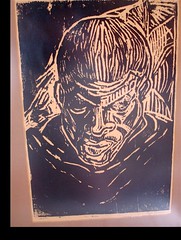
Woodblock print by Clyde Connell from the Caddo Parish Penal Farm, 1950's
Originally uploaded by trudeau
Clyde seemed energized by life alongside black prisoners at the Penal Farm. It reminded her of her childhood on the Dixon plantation. She loved listening to the singing of spirituals. She painted portraits and made woodblock prints of many inmates. She said that she gave most of the pieces to the prisoners.
Luna moth, a print by Clyde with Dixon Ent
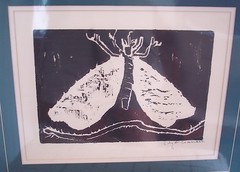
Deep Roots, the life and legacy of Clyde Connell, opens at Artspace Shreveport Sept 19
Originally uploaded by trudeau
Illustration from French magazine Beaux Arts advertising Clyde Connell exhibit in March, 1990

Deep Roots, the life and legacy of Clyde Connell, opens at Artspace Shreveport Sept 19
Originally uploaded by trudeau
We are indebted to Martha for her loan of art, framing of work by Dixon Ent, videotaped interviews of Clyde and deep background stories on the life and travels of Clyde.
Deep Roots, the life and legacy of Clyde Connell, opens at Artspace Shreveport Sept 19.
Thursday, July 3, 2008
Bryan Anthony Colvin, great grandson of Clyde Connell
Recent work by Bryan Anthony Colvin will be part of the legacy show. He is Clyde's great grandson and is currently residing at Clyde's place in the studio next door to Bryan's.
Friday, April 11, 2008
Bennett Sewell and Sheri Childs with his new sculpture , Shreveport , 2008

Bennett Sewell and Sheri Childs with his new sculpture , Shreveport , 2008
Originally uploaded by trudeau
Bennett Sewell Sculpture , Shreveport
Bennett Sewell, nephew of Clyde Connell, will also be exhibiting his art in the upcoming ARTSPACE show in Shreveport, entitled 'The Artistic Legacy of Clyde Connell ' running September 19 through October 25 , 2008.
Sunday, March 30, 2008
Three books on the life and work of Clyde Connell
The Charlotte Moser biography, Clyde Connell: The Art and Life of a Louisiana Woman (paperback) is a bargain at Amazon.com and a terrific and essential book.
Another of the great books on Clyde is the exhibition catalog called Clyde Connell, Daughter of the Bayou, edited by Meadows Museum director Diane DuFilho. It is rich in photos and enticing in design. Daughter of the Bayou features an article by Lucy Lippard called "At Home in Art," an interview by Michael Sartisky called "Abstracting the Essence," and an extensive "A Catalog of Works." There are 68 pages.
Meadows Museum of Art, Centenary College, may have copies and / or may have references to people who trade in the copies of the paperback catalog, published in 2000.
Different Drummers is a Smithsonian softcover exhibition catalog available in the used art book market. In it Clyde is featured alongside 8 other outstanding American artists.
Different Drummers: large quarto, 11" high X 8 1/2" wide, 155 pages. 77 illustrations of the works in the Hirschorn show, in both color and black & white. Short intro and catalog entries by Frank Gettings, Curator of Prints and Drawings at the Hirschorn Museum. Thumbnail biographical sketches. Exhibition history and bibliography for each of the 9 artists featured. Softcover Publisher: Smithsonian Institution Press, Washington, D.C.: 1988.
The illustration above is a collection of paintings honoring Clyde by Talbot Hopkins Trudeau.
Another of the great books on Clyde is the exhibition catalog called Clyde Connell, Daughter of the Bayou, edited by Meadows Museum director Diane DuFilho. It is rich in photos and enticing in design. Daughter of the Bayou features an article by Lucy Lippard called "At Home in Art," an interview by Michael Sartisky called "Abstracting the Essence," and an extensive "A Catalog of Works." There are 68 pages.
Meadows Museum of Art, Centenary College, may have copies and / or may have references to people who trade in the copies of the paperback catalog, published in 2000.
Different Drummers is a Smithsonian softcover exhibition catalog available in the used art book market. In it Clyde is featured alongside 8 other outstanding American artists.
Different Drummers: large quarto, 11" high X 8 1/2" wide, 155 pages. 77 illustrations of the works in the Hirschorn show, in both color and black & white. Short intro and catalog entries by Frank Gettings, Curator of Prints and Drawings at the Hirschorn Museum. Thumbnail biographical sketches. Exhibition history and bibliography for each of the 9 artists featured. Softcover Publisher: Smithsonian Institution Press, Washington, D.C.: 1988.
The illustration above is a collection of paintings honoring Clyde by Talbot Hopkins Trudeau.
Friday, March 7, 2008
Pat Sewell , Lake Bistineau , Shreveport
Pat Sewell, a nephew of Clyde Connell's, holds one of his current paintings (from fall, 2007 ). Pat is one of several of Clyde's relatives who will be exhibiting their work in the upcoming show "The Artistic Legacy of Clyde Connell " ,opening September 19 and running until October 25, 2008 , at ARTSPACE, Shreveport
Dixon Ent, Richmond : Color print of his original art
One of several works by Dixon Ent, grandson of Clyde Connell, to be shown at the upcoming show "The Artistic Legacy of Clyde Connell" , September 19 , 2008, at ARTSPACE , Shreveport
Thursday, March 6, 2008
David Sewell and an early painting by Clyde Connell
David Sewell is one of Clyde's great nephews. He lives in Jackson, Mississippi and works with his brother, Patrick Sewell Jr., M.D., of Jackson.
Clyde Connell, Jerry Wray in the 1960's
Clyde Connell and Jerry Wray were among the early modernists in Shreveport. Both drew considerable attention in the conservative city with their abstract pieces.
Subscribe to:
Posts (Atom)


